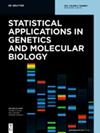亚硫酸酯测序数据差异甲基化鉴定的五种统计方法比较
IF 0.9
4区 数学
Q3 Mathematics
Statistical Applications in Genetics and Molecular Biology
Pub Date : 2016-04-01
DOI:10.1515/sagmb-2015-0078
引用次数: 20
摘要
摘要:我们对亚硫酸酯测序(BS)数据开发的五种差异甲基化(DM)鉴定方法:methylKit、BSmooth、BiSeq、HMM-DM和HMM-Fisher进行了全面的比较分析。我们从几个分析方面总结了这些方法的特点,并使用模拟和真实BS数据集比较了它们的性能。我们的比较结果总结如下。首先,参数设置可能在很大程度上影响DM识别的准确性。与默认设置不同,修改后的参数设置产生更高的灵敏度和/或更低的误报率。其次,在识别长且组内变异小的模拟糖尿病区域时,这五种方法都显示出更准确的结果,但它们的一致性较低,可能是由于它们用于糖尿病识别的方法不同。第三,HMM-DM和HMM-Fisher的敏感性相对较高,假阳性率相对较低,特别是在变异较大的DM区域。最后,我们发现在涉及甲基化估计的三种方法(methylKit, BSmooth和BiSeq)中,BiSeq可以最好地呈现原始甲基化信号。因此,基于这些结果,我们建议用户根据其数据的特征和每种方法的优势来选择DM识别方法。本文章由计算机程序翻译,如有差异,请以英文原文为准。
Comparing five statistical methods of differential methylation identification using bisulfite sequencing data
Abstract We are presenting a comprehensive comparative analysis of five differential methylation (DM) identification methods: methylKit, BSmooth, BiSeq, HMM-DM, and HMM-Fisher, which are developed for bisulfite sequencing (BS) data. We summarize the features of these methods from several analytical aspects and compare their performances using both simulated and real BS datasets. Our comparison results are summarized below. First, parameter settings may largely affect the accuracy of DM identification. Different from default settings, modified parameter settings yield higher sensitivity and/or lower false positive rates. Second, all five methods show more accurate results when identifying simulated DM regions that are long and have small within-group variation, but they have low concordance, probably due to the different approaches they have used for DM identification. Third, HMM-DM and HMM-Fisher yield relatively higher sensitivity and lower false positive rates than others, especially in DM regions with large variation. Finally, we have found that among the three methods that involve methylation estimation (methylKit, BSmooth, and BiSeq), BiSeq can best present raw methylation signals. Therefore, based on these results, we suggest that users select DM identification methods based on the characteristics of their data and the advantages of each method.
求助全文
通过发布文献求助,成功后即可免费获取论文全文。
去求助
来源期刊
CiteScore
1.20
自引率
11.10%
发文量
8
审稿时长
6-12 weeks
期刊介绍:
Statistical Applications in Genetics and Molecular Biology seeks to publish significant research on the application of statistical ideas to problems arising from computational biology. The focus of the papers should be on the relevant statistical issues but should contain a succinct description of the relevant biological problem being considered. The range of topics is wide and will include topics such as linkage mapping, association studies, gene finding and sequence alignment, protein structure prediction, design and analysis of microarray data, molecular evolution and phylogenetic trees, DNA topology, and data base search strategies. Both original research and review articles will be warmly received.

 求助内容:
求助内容: 应助结果提醒方式:
应助结果提醒方式:


